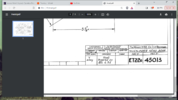Don't believe any of those websites as most are wrong info and are modern interpertations written since the internet was invented. Especially the british fasteners website which is an American interpertation of cycle thread where they have just assumed all was 60 degrees which is wrong.Is ADM the same thread? I just googled BSC and the 5 links I viewed say 60 degrees?
I have a copy of a the factory drawing for the driveside crankcase half here which I have just dug out. On it the threaded holes for the cylinder studs is specified as 9/16" x20 CEI where CEI is one way of writing cycle thread but the drawing doesn't say the thread angle.
The defining document that explains what cycle threads are is exactly is BS811. In the UK where these bikes were made, threads and other engineering specifications were defined in the British Standards documents.
Here is a link to a copy of BS811 and its dated 1950 with a 1951 revision which is perfect as its exacly from the time when Vincents were been made.
If you read the document it shows a diagram which does say 60 degrees which is where the confusion comes from because on the same page it also says the 20 TPI series uses an alternative Whitworth form. Now Whitworth form was always 55 degrees.
If you read the rest of BS811 what you will see in table 1 that they start at 40 TPI for 1/8", then 32 TPI for 5/32 & 3/16 and then settle at 26 TPI right up to 3/4" size. Now this is the standard 60 degrees form and nowhere on that list is 9/16x20 TPI which is what we are looking for.
There are then other tables for strange CEI threads including spoke threads.
Further down the document Apendix A is the first time 20 TPI is mentioned and in that appendix it shows 9/16 20 TPI. At the top of that appendix table it says these are British Standard Whitworth form. Now Whitworth form was always 55 degrees.
So according to BS811 which is the document that defines what cycle threads are all cycle threads are 60 degrees except the 20 TPI series which were Whitworth form and so 55 degrees.
None of this is to be confused with 9/16" 20 TPI UNF which is an American thread and is 60 degrees.
This also agrees with Know Thy Beast which lists the thread as 9/16 20 TPI Whitworth form, so I rest my case. This is the last I will comment on it as I'm getting bored and also got the Winter Pennine rally to go to this weekend.

